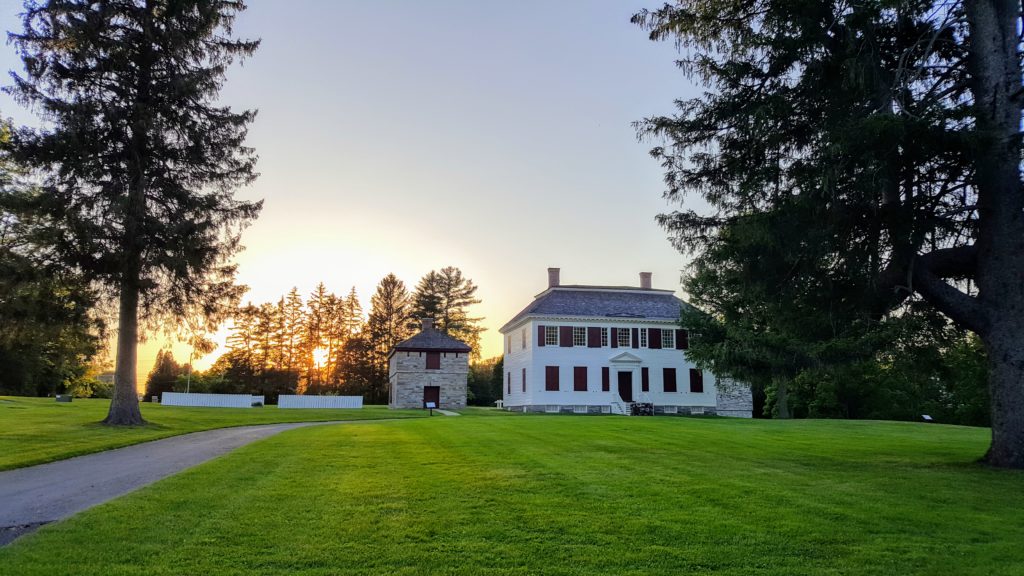
June 2018. DeBruin.
OFFICIAL BRIDGE ANNEX PRESS RELEASE
BACKGROUNDER:
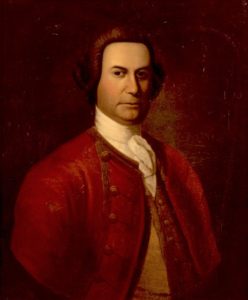 “Johnson Hall was the 1763 Georgian-style estate of Irish immigrant Sir William Johnson (1715 – 1774) and Molly Brant, a Mohawk Indian, and their eight children. Johnson was the largest single landowner and most influential individual in the colonial Mohawk Valley. His success in dealing with the Six Nations of the Iroquois greatly influenced England’s victory over France for control of colonial North America. For his service, the British Crown bestowed upon Johnson the title of Baronet, and later appointed him Superintendent of Indian Affairs, a position to which he devoted himself and held throughout his life.
“Johnson Hall was the 1763 Georgian-style estate of Irish immigrant Sir William Johnson (1715 – 1774) and Molly Brant, a Mohawk Indian, and their eight children. Johnson was the largest single landowner and most influential individual in the colonial Mohawk Valley. His success in dealing with the Six Nations of the Iroquois greatly influenced England’s victory over France for control of colonial North America. For his service, the British Crown bestowed upon Johnson the title of Baronet, and later appointed him Superintendent of Indian Affairs, a position to which he devoted himself and held throughout his life.
Differing cultures, traditions and languages combined to create a unique life for the Johnson family, with the Hall bustling with activity as home life and business life intermingled daily. Visitors included members of various Indian tribes, sometimes numbering in the hundreds at Council gatherings. The home was the centerpiece of a 700-acre working estate, with gardens, a mill, blacksmith shop, Indian store, barns, slave and servant housing and other essential buildings.
Following the death of Sir William in 1774, Molly and her children left Johnson Hall, and his eldest son John inherited the property and title of Baronet. The Revolution would cause this Loyalist family to eventually flee to Canada, and the Johnson Hall property and most of its contents were subsequently sold at auction following the War. Johnson Hall remained a private residence through 1906, when it was acquired by the State of New York and opened to the public as a State Historic Site. Today, Johnson Hall continues to welcome visitors and interpret the Johnson family through guided tours of the period room settings and of the historic grounds, educational programs and special events.”
Source: New York State: Parks, Recreation and Historic Restoration (https://parks.ny.gov/historic-sites/10/details.aspx)
Importance of Johnson Hall in Telling the History of the United Empire Loyalists
The significance of Johnson Hall in telling the story of so many United Empire Loyalists cannot be underestimated. Key historical figures including: Sir William Johnson[1], Sir John Johnson[2] and Molly konwatsitsiaienni Brant[3], among many others in relation to this historic site are not only interpreted in detail throughout the site itself, but also through the events that the Directors create to engage the public. In addition, staff are extremely knowledgeable about Loyalist history and even provide insight to Loyalist families seeking to better understand the history of their ancestors in the Mohawk Valley.
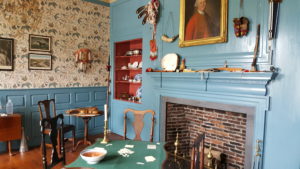 It is important to remember that we can only fully understand the experience of our United Empire Loyalist ancestors by knowing more of their history – not just that which began after the American Revolution. To know the history of these once colonial Americans, is to understand the dire circumstances they found themselves in at the outbreak of war. Places such as Johnson Hall provide a tangible reminder of the time of so many Loyalists prior to the outbreak of war; a war which saw many of our Loyal ancestors facing the known enemy, once called family and friends. To label this a ‘civil war’ would not be overstating the dreadful situation our ancestors faced. In order to understand their life in America, the experiences of the men, women and children before, during, and after the American Revolution, must be interpreted. Places such as Johnson Hall are an integral part of the education and outreach opportunities for only only descendants of the UE Loyalists, but those who are just discovering this part of our North American story. Along with the work UELAC continues to put into ensuring Loyalists are not forgotten, it is places such as Johnson Hall that are our partners in ensuring the places they once called home, the places they saw in their lifetimes, yet exist. Tangibility is a powerful tool to helping people connect with a past that seems
It is important to remember that we can only fully understand the experience of our United Empire Loyalist ancestors by knowing more of their history – not just that which began after the American Revolution. To know the history of these once colonial Americans, is to understand the dire circumstances they found themselves in at the outbreak of war. Places such as Johnson Hall provide a tangible reminder of the time of so many Loyalists prior to the outbreak of war; a war which saw many of our Loyal ancestors facing the known enemy, once called family and friends. To label this a ‘civil war’ would not be overstating the dreadful situation our ancestors faced. In order to understand their life in America, the experiences of the men, women and children before, during, and after the American Revolution, must be interpreted. Places such as Johnson Hall are an integral part of the education and outreach opportunities for only only descendants of the UE Loyalists, but those who are just discovering this part of our North American story. Along with the work UELAC continues to put into ensuring Loyalists are not forgotten, it is places such as Johnson Hall that are our partners in ensuring the places they once called home, the places they saw in their lifetimes, yet exist. Tangibility is a powerful tool to helping people connect with a past that seems 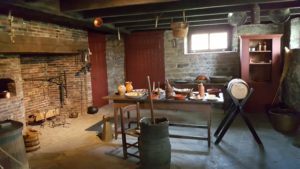 very far back until they can touch, see, and explore the places of that time. Suddenly, they might imagine themselves in that time and place, and they are ‘hooked.’ A visit to Johnson Hall is a powerful experience for descendants of the area. While all are made to feel welcome, UE Loyalist descendants are made to feel as though they are ‘home,’ and share in the story. Helping to ensure that the places our ancestors came from are preserved by groups and organizations dedicated to a multi-faceted telling, provides invaluable educational opportunities not only for the descendants of UE Loyalists, but also the public at large, which enhances UELAC’s ability to engage and interest others in preserving our complex and fascinating history.
very far back until they can touch, see, and explore the places of that time. Suddenly, they might imagine themselves in that time and place, and they are ‘hooked.’ A visit to Johnson Hall is a powerful experience for descendants of the area. While all are made to feel welcome, UE Loyalist descendants are made to feel as though they are ‘home,’ and share in the story. Helping to ensure that the places our ancestors came from are preserved by groups and organizations dedicated to a multi-faceted telling, provides invaluable educational opportunities not only for the descendants of UE Loyalists, but also the public at large, which enhances UELAC’s ability to engage and interest others in preserving our complex and fascinating history.
-
[1] Sir William Johnson. Dictionary of Canadian Biography http://www.biographi.ca/en/bio/johnson_william_4E.html
-
[2] Sir John Johnson. Dictionary of Canadian Biography http://www.biographi.ca/en/bio/johnson_john_6E.html
-
[3] Molly Konwatsitsiaienni Brant. Dictionary of Canadian Biography http://www.biographi.ca/en/bio/konwatsitsiaienni_4E.html
Johnson Hall Restoration Project
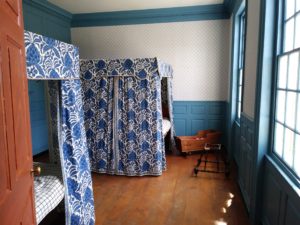
Children’s Room Restored. Johnson Hall, Johnstown, NY. Photo Courtesy: Johnson Hall State Historic Site
Overview provided by Wade Wells, Historic Site Manager, Johnson Hall (excerpt from email to Jennifer DeBruin UE)
“The following project breakdown is for restoration work that remains un-funded to complete the restoration of both the first and second floor main hallways of Johnson Hall. The site staff and The Friends of Johnson Hall chose to undertake this project as its completion would provide the most profound first impression of the mansion and of Sir William’s ability to acquire decorative materials from across the globe to furnish his colonial frontier mansion. Hence the title of the project “Majesty on the Frontier.”
It is important to know that we have already completed some of the necessary restoration work and have recently acquired some of the decorative elements needed to complete the restoration of the hallways.
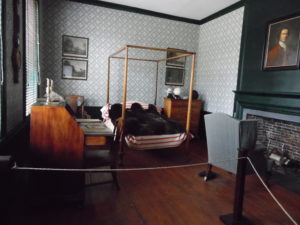
Sir William Johnson’s Room Restored. Johnson Hall. Photo Courtesy: Johnson Hall State Historic Site
- The Friends of Johnson Hall and the site cost shared the ceiling plaster and paint finish repairs totaling $4,800.
- The Friends received a grant from Parks and Trails New York for $ 9,600 to install a marbleized painted canvas floor cloth in the first floor hallway. Crafting of the floor cloth will begin soon with an eye to install sometime in the Spring of 2019.
- The Site purchased a new glass lantern for the first floor hallway costing $ 500.00 The Friends for Johnson Hall received a gift of $ 7,200 from St George’s Lodge F&AM to have the wooden blocks carved to print the Pillar and Arch wallpaper for the first and second floor hallways. The Site and the Friends of Johnson Hall have committed to cost share the following two projects, to be completed Spring 2019.
- Repair the first and second floor hallway plaster walls. $ 4,800. Restore the hallway crown molding and Palladian window with appropriate period paint finishes. $3,100
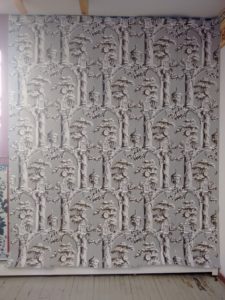
Pictured above: “The wallpaper manufacturer Adelphi Paper Hangings in Sharon Springs New York. These were the initial strikes taken to prove the carved wooden printing blocks would print clearly. Though we have not worked out the final colorways this is the pattern that will be used in the first and second floor mansion hallways. Pillar and arch patterns papers were commonly used in large spaces such as hallways. This original paper was discovered in the Parson Smith house in Maine. Its importation and installation correspond to the same time period that Sir William was applying papers in the mid 1760’s.”
We are currently fundraising and seeking support for the following costs:
- 31 rolls of hand blocked period appropriate pillar and arch wallpaper for the first and second floor hallways: $ 8,500
- Restoration of the faux mahogany paint graining on the first and second floor hallway wainscoting and doors: $ 4,250
- Installation of hand blocked period correct wallpaper and an acid free wallpaper liner to protect and support the hand blocked paper. Cost of acid free paper included in total: $10,100
This was a large project and a heavy lift for a small Friends organization and a Site with limited discretionary spending, which is why we have broken the project down to more manageable pieces.
The site and Friends group working together have managed to complete the wallpaper and paint finishes in Sir William’s and the Children’s rooms. Both have been met with very positive public response and increased donations to support current projects.
I realize that restoration costs can appear very daunting, but with the work properly completed and with proper care, we can easily expect our efforts to last for the next 50 to 75 years and possibly longer.
You should also be aware that the Office of Parks Recreation and Historic Preservation is currently pursuing the restoration of the roof at Johnson Hall using reproduction black glazed pan tiles based on archaeological evidence and references in the Johnson Papers. Our regional restoration carpenters will also be replicating rusticated siding material to restore a section of the mansions siding in the Spring morning 2019.
The site staff and the Friends of Johnson Hall very much appreciate any consideration the UELAC can give to our funding needs.” – Wade Wells, Historic Site Manager, Johnson Hall
Further Information/Upcoming Events:
Johnson Hall Facebook: https://www.facebook.com/johnsonhallstatehistoricsite
Fundraising Management:
All funds collected by UE Loyalists Bridge Annex (fundraising managers) will be donated on behalf of the members and friends of the United Empire Loyalists’ Association of Canada (UELAC).*
While tax receipts are not available, we hope you’ll consider contributing to ensure this site, so critical to the telling of the experience of the United Empire Loyalists, is preserved for generations to come.
*Fundraising efforts for Johnson Hall Restoration will end April 30, 2019 or before if funds required are attained prior to this date.
